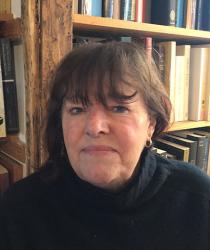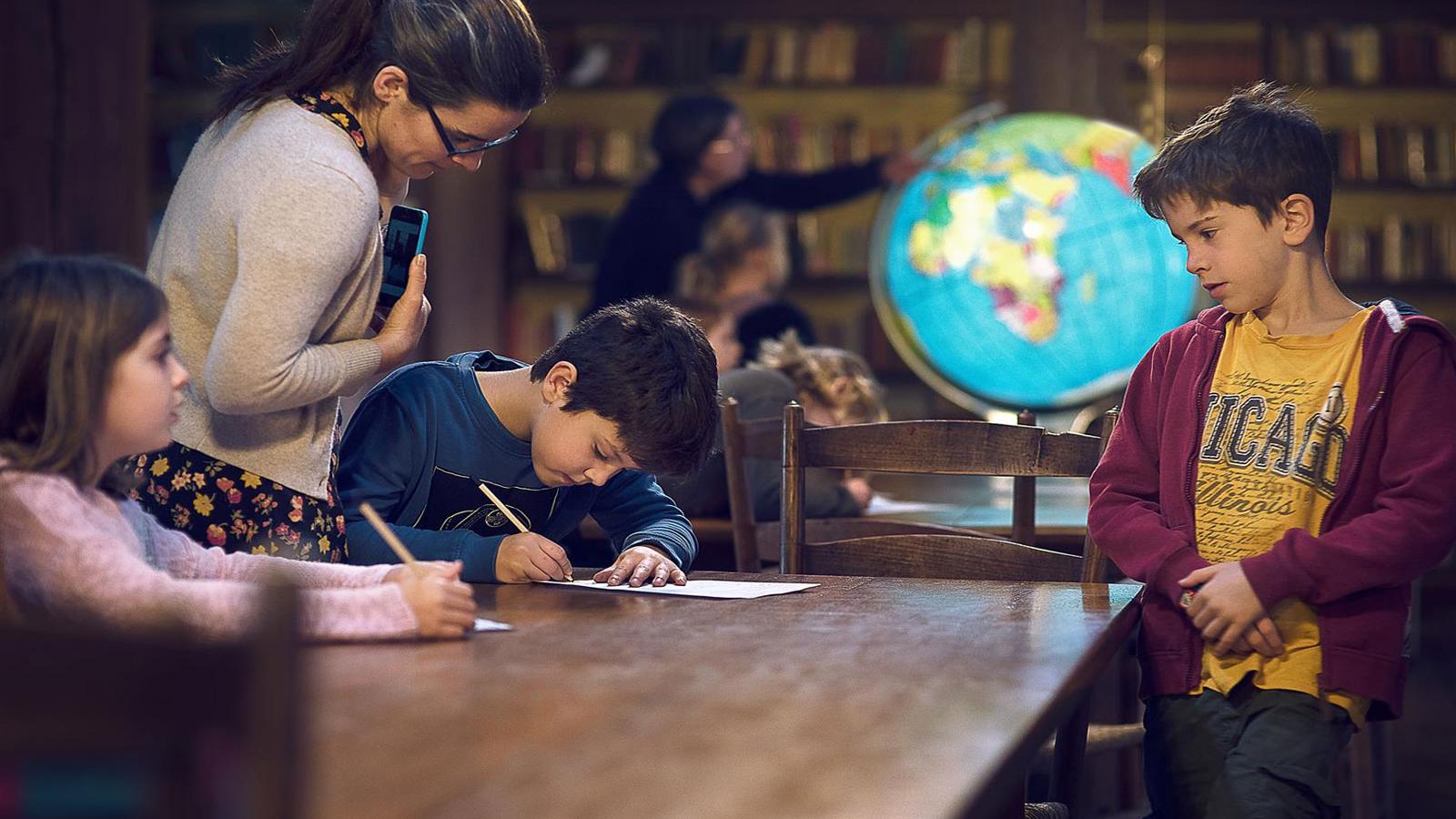
Today, Mary Hollingsworth is one of the great historians of Renaissance Italy. It seems amazing, therefore, that she was once barred from studying history at A-Level by Ruth Whiting, who later confessed to Mary’s sister that she had made one of her rare errors in this case. Mary talks about growing up at Bedales at a time when the 1960s was breathing new life throughout the world; her affection for the school shines through in her conversation, as do her determination and persistence in brushing aside obstacles to follow her chosen career path.
“As a young girl, I think that I was rather gauche, shy and selfish,” is Mary Hollingsworth’s candid self-assessment. “I grew up in the north of England, just south of Darlington, and my early school memories are of going to a good, old-fashioned local school where I was very well taught. It also still particularly sticks in my mind that I once played Mustardseed in a very chilly outdoor production of A Midsummer Night’s Dream!”
Mary’s mother was an Old Bedalian, as were most members of that side of her family, and in due course, she and her sisters would also follow that tradition. “My interview day for Dunhurst is something I remember very well,” she says. “It was extraordinarily exciting to see what seemed like the whole school playing outside in the orchard in an entirely unregimented style. Going to Dunhurst was therefore something that appealed greatly to me and sure enough, there were so many nice things about the place.”
Barn and woodworking were close to the top of the list of Mary’s ‘nice things’. “Mr Messingham, who was in charge of woodwork, had the highest standards,” Mary recalls. “One of my proudest achievements at Dunhurst was making an oak coffee table under his watchful eye. Mr Messingham’s wife taught me maths and she was another teacher from whom I learned a great deal, which really mattered to me. I wanted to learn; at Dunhurst, though, apart from the maths and the woodwork, I can’t say that academically, I picked up all that much. When I arrived at Bedales proper, I still hadn’t done anything significant in the way of history, Latin or modern languages.”
As Mary progressed through the school, the 1960s were beginning to shape attitudes and tastes at Bedales and far beyond. “When you’re a child from a rural North Yorkshire background, it doesn’t take too much to realise when something different is happening around you and out in the wider world,” Mary reflects. “It was a hugely exciting time to be alive; dorms were invariably decorated with posters of either the Beatles or the Rolling Stones and it was in one of those dorms that I learned how to do the twist! Somehow or other a record player would be plugged into a light bulb and you would constantly hear The House of the Rising Sun or something by Booker T. Music was such a huge deal at Bedales, it was a part of the zeitgeist and rock, jazz and classical music were also a major awakening interest of mine.”
Music was just one of Mary’s Bedales pursuits. “I was still quite keen on the practical stuff but sport wasn’t for me at all,” she says. “I got hay fever every summer, for a start. There were so many opportunities on offer wherever you looked, though, and I always felt encouraged to try as many of them as I fancied and then to play to my strengths. People at Bedales genuinely seemed to care about others, or at least tried to care, and that was particularly true of my fellow students such as Patricia Duncker, who were figures at least as inspirational as the best of my teachers. There was such a range of people at Bedales with such a range of abilities across the board – musicians, artists, writers and almost everything besides. The school nurtured every bit of talent and desire that we all possessed.”
Back on the academic front, Mary was making up the ground that she felt she had lost at Dunhurst, mostly successfully, but in history, a subject that she desperately wanted to pursue, too much ground had been lost, according to the formidably definite opinion of Ruth Whiting. “Ruth wouldn’t let me do history at A-Level because I was too far behind (she did later apologise to my sister Rosamund (Polly) for that), which meant that my combination of subjects – maths, German and geography – was somewhat unusual,” says Mary. “I was very lucky to have teachers as accomplished and enthusiastic as George Bird and Jolyon Goodman and it was the mechanics of learning that were such an important element of what they imparted to us. There always was a sense at Bedales that learning was special, something to be revered for its own sake and not merely as a tool for passing exams. It was absolutely the right environment for me despite the fact that I was regarded in some quarters as being a bit dangerous or edgy. I wasn’t, by the way, just a bit gauche, as I said before!”
It had been Mary’s original plan to take a gap year before going on to university but parental dictates decreed otherwise. “My mother and father were adamant that I should go straight away and I was feeling quite nervous about that because all my university choices had rejected me,” Mary remembers. “Then I was offered a place to read history – the course that I really wanted to study – at Coleraine, but my parents weren’t happy with that either. It was 1969, the Troubles had just broken out and it was all too uncertain for them. Finally an offer from Manchester University arrived to read maths and German, which was promptly accepted on my behalf by my mother! As it turned out, I failed my maths exam in Year 1 and switched to business studies but this was all a means to an end. I wanted to study history eventually; the only problem was that I couldn’t quite see how to get there yet.”
Armed with her degree, Mary had an immediate and pressing need to start earning a living and began her working life as an accountant at the Grosvenor Gallery in London. “Essentially it was keeping the books for the extraordinary couple who ran the gallery,” she explains. “In some ways, it could be quite an inspiring place to work because of the clientele one came into contact with – not many places could give you the chance to meet Gregory Peck or have a telephone conversation with Groucho Marx! Ultimately, though, I did find it a bit depressing, dealing with too many very wealthy people who knew the price of most things but had very little idea about the value of anything.”
A trip to Florence would have a seminal effect on the future direction of Mary’s career. “I came back absolutely determined that I would study art history and I began the process by taking a course in London where I did pretty well,” Mary says. “Subsequently, I was advised to study for an MA, not in London at the Courtauld Institute or somewhere like that but at the University of East Anglia (UEA), which had a superb art history department.”
Mary went on to do her PhD at UEA with a thesis on the role of the patron in the development of Renaissance art and architecture, a subject she later taught to undergraduates and postgraduates at the university. However, it was her decision to relocate to Italy for a substantial period that was the key to unlock all Mary’s potential as a writer and a historian. “Italy made all the difference in the world to me,” she confirms. “The time I spent in the archives at Modena reading the papers of Cardinal Ippolito d’Este enabled me to discover a treasure trove of source material that was so vast and so exhaustive that I was able to broaden my learning way beyond art history and into the stuff of everyday Renaissance life. Living history, if you like. My time as an accountant meant that I could read the cardinal’s account books and understand them; I could connect the art with the history and the more mundane aspects of life in sixteenth-century Italy.”
A stream of books and academic publications has subsequently emerged from the pen of Mary, who is now regarded as one of the pre-eminent authorities on the history of Renaissance Italy. Her most recent offerings are Conclave, the story of the papal election of 1559 based on the ledgers of Cardinal Ippolito, and Princes of the Renaissance, both published earlier this year by Head of Zeus to widespread acclaim, but her oeuvre now stretches back over more than three decades. Mary has taken her inspiration from a variety of quarters: “I met Lorna Sage in Florence and she was an amazingly inspirational writer and a person who was fascinated by all that life had to offer; she could find a speck of gold in anything. The historian John Julius Norwich was a friend of a friend, I got to know him a little and I loved the way that he knew so much about so many different things. However, and after all these years, I remain at least as inspired by my old Bedales friends and their accomplishments.”
It seems as though Mary’s alma mater is continuing to cast its benign spell over her. “I still remember the joy of walking into the library at Bedales and being surrounded by books,” she says. “Libraries mean a lot to me and when I returned to Bedales for a reunion in 2019, I was still awed by that building. I wish I could imbue that love into everyone else I meet. My sisters and I have always spoken a lot about Bedales and I live close to my brother, who has three sons; rather interestingly, the two oldest have partners who are Old Bedalians! I tend to think that you can tell Bedalians apart by their cast of mind alone – Bedalians tend to be enthusiastic, interesting and slightly wacky!”
The girl who was rejected as a prospective student by none other than Ruth Whiting hasn’t done too badly in Ruth’s old discipline, after all. “I think my teenage self would have been absolutely staggered by being asked to contribute to the wall of fame, alongside Patricia Duncker,” Mary suggests. “I suppose she’d have been relieved that I got there in the end as well and pleased that I did so while remaining the ‘conforming nonconformist’ that I always was, even at school. Schools that press students into uniformity or conformity are absolutely stifling places, in my opinion. It was my great good fortune that Bedales was the exact opposite.”
Mary Hollingsworth was interviewed by James Fairweather in Autumn 2021.

